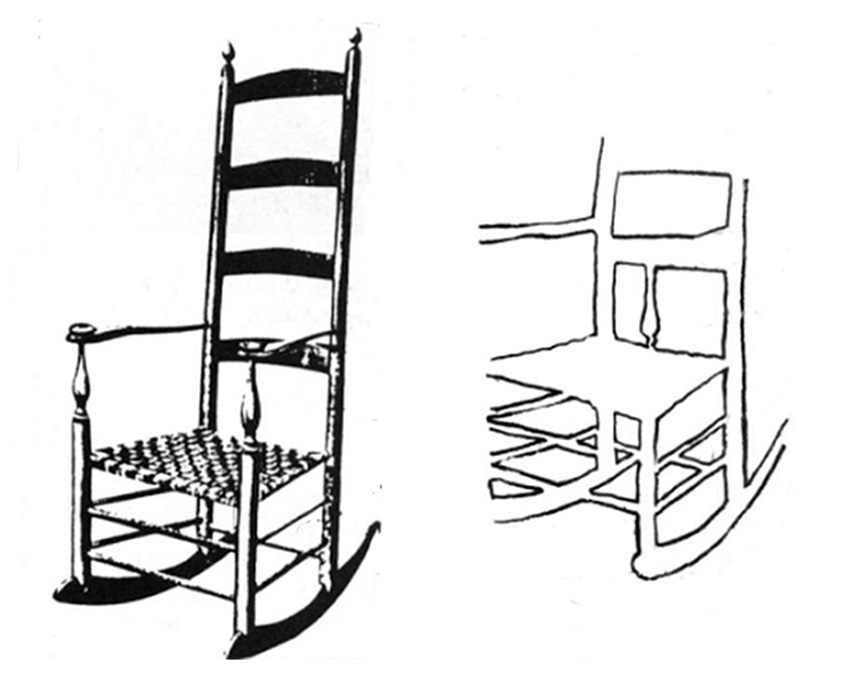Why avoid talking of “negative spaces ” or “negative shapes”?
The title of Chapter 6 of my book “Drawing on Both Sides of the Brain” is “Negative Shapes”. Some people may be surprised to find that I question the widespread use by art teachers of the phrase “negative shapes” and of its equivalent, “negative spaces“. After explaining the reasons for the popularity of its use as a means of bypassing the problems due to familiarity, I argue that it has significant shortcomings. In the light of these, I suggest that there are alternatives which avoid its disadvantages without relinquishing any of its advantages. Perhaps more importantly, these provides better ways of using drawing from observation as a tool for discovering the unique characteristics of objects in the world around us.
CHPTER 5 – “NEGATIVE SHAPES”
.
Examples of negative shapes


In the illustrations above, Figure 1 shows the famous face/vase illusion in which either the faces or the vase can be seen positively, but only alternately. Figure 2, shows a drawing of a chair (on the left) and a drawing made from it (on the right), using the existing “negative spaces” method. Although it comes originally from Betty Edwards, I found it on a website that discusses negative shapes and spaces, using the terms in their established meaning.
Other Posts that publish chapters from “Drawing on Both Sides of the Brain”.
- An inspirational 19th century teacher and his widespread influence on Modernism in drawing and painting
- Chapter 1: Accuracy versus expression
- Chapter 2: Traditional artistic practices
- Chapter 3: Modernist ideas that fed into new teaching methods
- Chapter 4: the sketch and explaining the feel-system.
- Chapter 6: Contour drawing
- Chapter 7: Copying Photographs
- Chapter 8: Fast drawing, learning and expression
Sorry Francis, I have difculties grasping this one…
I am sorry you are having difficulties. In a way I am not surprised because I felt it one of the most difficult chapter to write. But my main feeling was that one negative response from someone who has given so very many positive ones, gives all of those extra value, as coming from someone who can be negative when she feels it is appropriate. So thank you. I will look into trying to make myself clearer.
As always, illuminating. Your posts are always a reminder about different ways to look at things.
Thanks Francis for revising this chapter and making it clearer. I have never read an article that reflects so thoroughly on the subject of negative shapes. You offer new and fascinating insights that are well worth taking into consideration.
Thank you so much, dear Francis, for this further clarification. Now even a slow learner as myself grasps the larger implications of what it is you teach us in this chapter. Fascinating!
très interessant
Francis, thank you for this chapter. I had to work to grasp everything I was reading, and already know I want to reread it, even more carefully; but the information in this chapter is enormously helpful in the still life sketches I am currently working on. Information from this chapter also helped me a lot during the life drawing class this morning. That was a good session! Glad there will be more. Thanks.
Hi Francis, reading this chapter again, two years later, is enormously helpful. My focus on enclosed spaces will be very present tomorrow morning when I go out again to draw. I want to add: I am glad for this chapter, particularly because my ability to draw more comfortably and accurately took a giant leap the summer you spent time with us thinking about enclosed spaces. Suddenly, almost intuitively, enclosed spaces gave me a working anchor for beginning to understand how things fit together. I’m thanking you for the chapter, as well as the insight, because this big learning concept had slipped way back into the deep generalities of my mind. Being able to recontact to that vital information through this chapter makes me feel excited and even eager to face, again, my long, sometimes very tedious, process of learning. Again, thank you.
Well, dang if I didn’t, again, get tons of personally helpful, concretely useful drawing information, even though I’d just re-read this very chapter a month ago. I think it’s because the information in this chapter speaks directly to the very nub of my personal difficulty in decoding what I see in order to draw.
Thank you for this! I have never read anything else that goes as deeply into the concept of ‘negative shapes’. I so appreciate the discussion and insights you offer. I’d like to see more images in conjunction with everything you write about. I feel that would help clarify what you share.